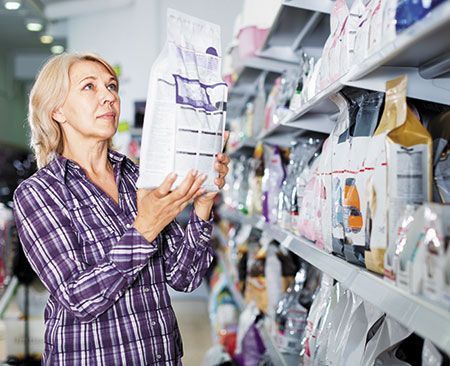Purchasing power: How pet owners make pet food decisions
Check out the most common nutrition questions pet owners ask at big box stores.
Caftor/shutterstock.com

The pet food market is abundant with options-grain-free, raw, those pesky chicken byproducts, and non-traditional protein-based diets. How do pet owners know what's best for their pet?
Hopefully they've had a conversation with their veterinarian and can make a beeline directly to the food they need amongst the hundreds of options in the aisles. But if they haven't, or they don't feel their veterinary team has given them enough answers, they're likely wandering the aisle, asking the pet store employees-or choosing based on which commercial they've seen most recently.
Jesse Dorland, business manager for Bigger Road Veterinary Clinic in Kettering and Springboro, Ohio, has managed the ins and outs of pet retail in a veterinary clinic and on the other side of the fence at a large pet retail store. Here he shares the most common questions pet owners asked the retail store.
Many pet owners were looking for solutions to inappetence and food sensitivities or allergies, Dorland says. People also sought alternatives to therapeutic diets because of cost or because the ingredients didn't jibe with what they wanted in a pet food.
“Often people would ask us questions [at the pet retail store] they really should have been asking their veterinarians. But either their vet wasn't prioritizing those discussions with them, or they didn't like the answers their vet was giving them,” Dorland says.
Consumer preferences have changed in the last 10 years as well, Dorland says. The cultural shift toward natural, organic and non-GMO human foods has crossed over into pet foods as well.
“There's room for veterinarians to acknowledge and work within clients' preferences for pet food-even in cases where we don't believe there is a medical basis for them-and still be involved in the conversation to positively influence the health of the pet,” he says.
“When a client has a preconceived idea about what they want to see in a pet food and they feel dismissed or invalidated by their veterinarian, that's when we entirely lose the pet food conversation to the pet store, which isn't good for anyone,” Dorland says. “Pet store employee training is a huge question mark, and pet food marketing is incredibly confusing. Veterinarians should be involved in that conversation. Clients with a strongly held opinion that ‘natural is better' in pet food usually apply that to all facets of their life, and a veterinarian is not likely to change a client's basic worldview. But we can lose the client's trust by seeming inflexible or dismissive in the conversation about pet food.”
Another important category of pet owner: those who came to the pet store looking for new food. Dorland says in many cases these pet owners didn't know what they wanted. He said they often used the specific adjective “better”-as in, “I want a better food.” Many also wanted to solve a specific problem, like diarrhea or itching, but they weren't exactly sure what they were looking for.
“This is a big problem because it puts them at the mercy of pet store employees whose training about the hundreds of different foods is, statistically, probably pretty inadequate,” he says.
For about two years, Bigger Road Veterinary Clinic carried a small selection of over-the-counter diets, mainly for food sensitivity and allergy issues. Their goal: to offer a specific diet for clients who resisted therapeutic diets because of cost or because they objected to the ingredients used. Then, if the over-the-counter diet worked for the pet, the client could continue purchasing the food at the pet store and be sure they were feeding a diet approved by the veterinarian.
“Because of the way over-the-counter diets are marketed, and the lack of training for many pet store employees, sending a client to the pet store to get a salmon diet for a food trial is pretty likely to result in the client bringing home something that's full of chicken,” Dorland says.
In the end, the economics of carrying the over-the-counter diets didn't really work for the clinic. “We were dealing with expired product and also high cost of goods because of the low volume we were purchasing. During this time, natural veterinary diets became widely available. And for in-clinic dispenses they are actually more cost-effective for both us and the clients, which is great,” Dorland says.
“We do think there is a huge opportunity for online pharmacies to expand their over-the-counter diet offerings to include more natural and cost-effective options. Online over-the-counter diet sales would be a new revenue stream for vet clinics and a great opportunity to increase client compliance and also improve staff education about what clients are seeing at the pet store,” he says. “Many of our clients are very comfortable with our online pharmacy platform and would jump at the chance to have their pet's non-therapeutic diets delivered to their door at a competitive price."
